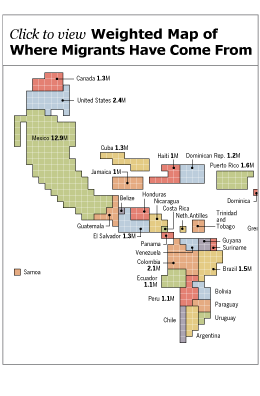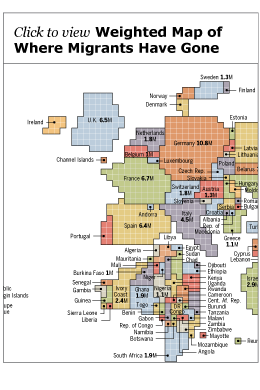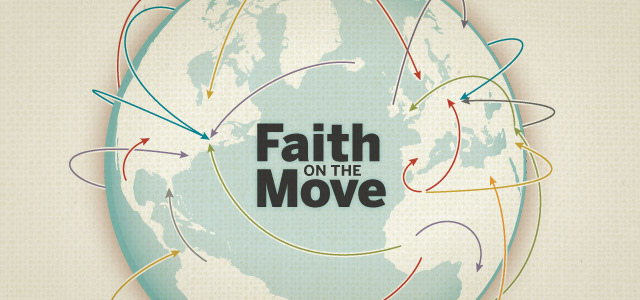
About 3% of the world’s population has migrated across international borders. While that may seem like a small percentage, it represents a lot of people. If the world’s 214 million international migrants were counted as one nation, they would constitute the fifth most populous country on the globe, just behind Indonesia and ahead of Brazil.
Faith on the Move, a new study by the Pew Research Center’s Forum on Religion & Public Life, focuses on the religious affiliation of international migrants, examining patterns of migration among seven major groups: Christians, Muslims, Hindus, Buddhists, Jews, adherents of other religions and the religiously unaffiliated.
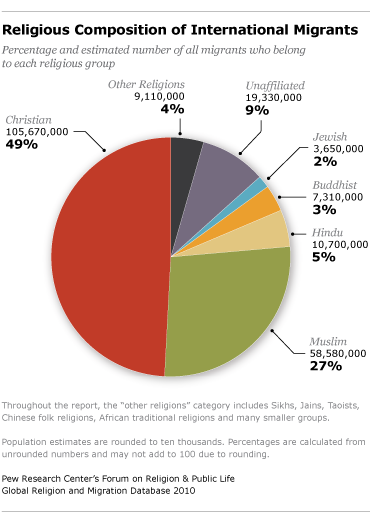
Christians comprise nearly half – an estimated 106 million, or 49% – of the world’s 214 million international migrants, the total number of people who reside permanently in a country other than where they were born. (See Defining International Migrants box. All figures in this report are as of 2010.)
Muslims make up the second-largest share of people who have migrated across borders – almost 60 million, or 27% Hindus (nearly 11 million) account for 5%) and Buddhists (about 7 million) account for 3%.
There are more than 3.6 million Jewish migrants living around the world (nearly 2%). Adherents of all other faiths – including Sikhs, Jains, Taoists, Chinese folk religions, African traditional religions and many smaller groups – collectively account for an estimated 9 million migrants (4%).
The rest of the world’s cumulative “stock” of migrants (more than 19 million, or 9%) is unaffiliated. This category includes atheists, agnostics and people who say they have no particular religion.
In some respects, the religious affiliation of migrants mirrors the religious composition of the world’s overall population. For instance, Christians and Muslims are the two largest religious groups among migrants as well as the two largest religious groups in general.1
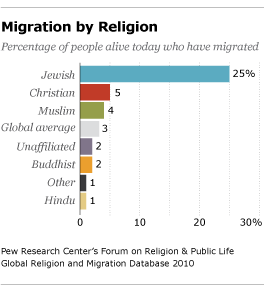
At the same time, however, Christians clearly are overrepresented among international migrants. They comprise a much greater share of migrants (about one-in-two) than they do of the general population (nearly one-in-three). Muslims also appear to be overrepresented among migrants, but not by as large a margin. They comprise only a slightly higher share of migrants (27%) than of the world’s total population (23%). Together, Christians and Muslims account for about half the people in the world, but they make up an estimated three-quarters of all those who have emigrated from their country of birth, as of 2010. The remaining quarter belong to smaller groups. Some, like Jews, make up a larger share of migrants (nearly 2%) than they do of the world’s total population (less than 1%). For other groups, the opposite is true. Hindus, for example, comprise about 5% of international migrants but 10-15% of the global population.
Another way to look at the same data is to ask: What proportion of the living members of each religious group have migrated across international borders? Of the seven groups considered in this study, Jews have by far the highest level of migration, in percentage terms. About one-quarter of Jews alive today (25%) have left the country in which they were born and now live somewhere else. The proportions of Christians (5%) and Muslims (4%) who have migrated across borders also exceed the global average of 3%. Members of all the other major religious groups have migrated at levels lower than the global average of 3%.
Defining International Migrants
According to the United Nations Population Division, an international migrant is someone who has been living for one year or longer in a country other than the one in which he or she was born. This means that many foreign workers and international students are counted as migrants. Additionally, the U.N. considers refugees and, in some cases, their descendants (such as Palestinians born in refugee camps) to be international migrants. For the purposes of this report, estimates of the number of unauthorized or illegal immigrants living in various countries also are included in the total counts. On the other hand, tourists, foreign-aid workers, temporary workers employed abroad for less than a year and overseas military personnel typically are not counted as migrants. The figures in this report refer to the total number (or cumulative “stocks”) of migrants living around the world as of 2010 rather than to the annual rate of migration (or current “flows”). Since migrants have both an origin and a destination, international migrants can be viewed from two directions – as an emigrant (leaving an origin country) or as an immigrant (entering a destination country).
Overall Patterns in Global Migration
Before looking more closely at patterns of migration among the seven major religious groups, it may be helpful to see where international migrants, as a whole, have come from and where they have gone.
Origins
As the Origins cartogram (weighted map) graphically shows, migrants come from every inhabited part of the globe, and no one continent or region is the source of a majority. The largest single share – about a third of the 214 million migrants living around the world – has come from the Asia-Pacific region. The second-largest group of migrants (about 28%) is from Europe, largely the result of people moving from one European country to another. Latin America and the Caribbean rank as the third-highest source of migrants (about 16%). Finally, sub-Saharan Africa and the Middle East-North Africa region each are the origin of about 10% of all international migrants alive today, and North America is the origin of roughly 2%.
In terms of individual countries, the leading sources of international migrants have been Mexico, India and Russia. More than 10 million people have left each of those countries and now live elsewhere. In addition, China has been the source of more than 8 million emigrants, and Bangladesh and Ukraine each have been the source of more than 6 million.
Destinations
While migrants come from a very diverse and widespread array of countries, the vast majority end up immigrating to a relatively few areas – North America, Europe, Australia and the Arab states of the Persian Gulf, as shown on the Destinations cartogram.
North America and Europe have received more than half of the newcomers: As of 2010, about a third of all international migrants live in Europe, and nearly a quarter reside in North America. About one-fifth of international migrants have moved to the Asia-Pacific region, settling in such places as India, Australia, Pakistan, Kazakhstan, Hong Kong and Malaysia. Smaller numbers of migrants have ended up in the remaining three regions: the Middle East-North Africa, sub-Saharan Africa and Latin America plus the Caribbean.
Among destination countries, the United States is in a class by itself. About one-in-five international migrants alive today (nearly 43 million, including unauthorized immigrants and people born in U.S. territories, such as Puerto Rico and Guam) reside in the United States. This is more than three times the number that reside in any other country. Only Russia and Germany also exceed the 10-million mark. In fact, the United States has about as many immigrants from Mexico alone (more than 12 million, including both legal immigrants and unauthorized ones) as any other nation has received from all sources combined.
Among the world’s other Top 10 destinations for migrants have been Saudi Arabia (7.3 million foreign-born residents), Canada (7.2 million), France (6.7 million), the United Kingdom (6.5 million), Spain (6.4 million), India (5.4 million) and Ukraine (5.3 million).
Patterns in Migration, by Religion
Origins
Globally, the top country of origin for Christian migrants has been Mexico (more than 12 million). Other major sources of Christian migrants include Russia (more than 8 million) and Ukraine (about 5 million), mostly due to changing international borders following the collapse of the Soviet Union. There also have been millions of Christian emigrants from the United Kingdom and the Philippines.
The largest share of the world’s Muslim migrants is Palestinian in origin (more than 5 million), followed by Pakistan, Bangladesh and India (more than 3 million each). The main sources of Jewish migrants are Russia (more than 700,000) and Ukraine (290,000). The top country of origin for Buddhist migrants is Vietnam, followed closely by China (more than 1 million each). Hindu migrants have come overwhelmingly from India (more than 5 million). China has been the largest source of migrants belonging to other religions (2 million) as well as the primary country of origin for migrants who are religiously unaffiliated (4 million).
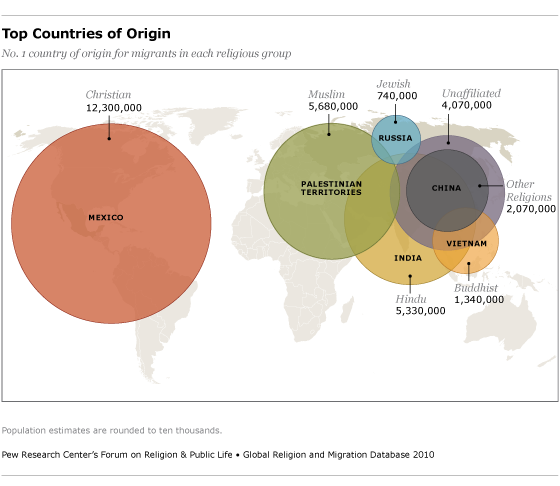
Destinations
With its huge population of immigrants, the United States has been a leading destination for many, though not all, religious groups. The U.S. is the world’s No. 1 destination for Christian migrants, who make up nearly three-quarters (74%) of all foreign-born people living in the United States. The United States is also the top destination for Buddhist migrants (including many from Vietnam) and for people with no particular religious affiliation (including many from China). It is the world’s second-leading destination for Hindu migrants, after India, and for Jewish migrants, after Israel. Among Muslim migrants, however, the United States ranks just seventh as a destination – behind Saudi Arabia, Russia, Germany, France, Jordan and Pakistan. (For more details, see Spotlight on the United States).
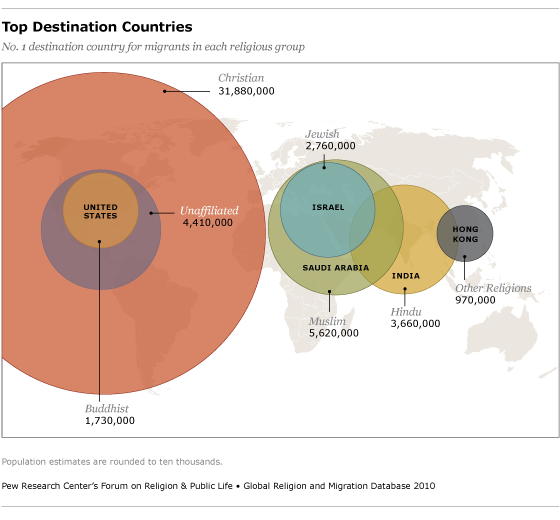
European countries also have been major destinations for migrants of many faiths. Russia, for example, has about 4 million Muslim immigrants, mostly from neighboring former Soviet republics, while Germany and France each are estimated to have more than 3 million first-generation (foreign-born) Muslim residents. Perhaps contrary to popular perception, however, Christian immigrants outnumber Muslim immigrants in the European Union as a whole. The 27 E.U. member countries collectively have an estimated 26 million Christian immigrants (56% of the foreign-born population) and nearly 13 million Muslim immigrants (27%). Even when migration within the E.U. is excluded, the estimated number of foreign-born Christians (about 13 million) is still slightly larger than the estimated number of foreign-born Muslims (about 12 million) living in the European Union. (For more details, see Spotlight on Europe.)
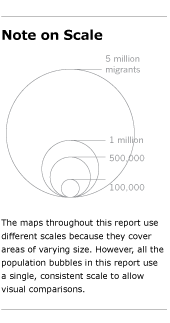
The six countries of the Gulf Cooperation Council (Bahrain, Kuwait, Oman, Qatar, Saudi Arabia and the United Arab Emirates) also have large populations of foreign-born residents, ranging from about a quarter to more than 80% of each country’s total population. Although they are often legally treated as temporary workers rather than as immigrants, many labor migrants routinely renew their work permits and stay on in the GCC countries for years. Over time, this influx could bring significant change in the religious composition of these once overwhelmingly Muslim nations. While a majority of migrants to all the GCC countries are estimated to be Muslims, they also include substantial minorities of other faiths, including Hindus and Christians. (For more details, see Spotlight on the Gulf Cooperation Council Countries.)
These are among the key findings of Faith on the Move. The report draws from hundreds of censuses and surveys to arrive at estimates of the size and religious affiliation of immigrant populations in 231 countries and territories as of 2010.
About the Estimates
Since migrants by definition move around, tracking their origins and destinations is not easy. The fact that many come from countries that keep only rudimentary records adds to the challenge. Determining their religious affiliation is even harder – which may be why, until now, no religious breakdown has been available for international migrants as a whole. The Pew Forum’s new Global Religion and Migration Database (GRMD) seeks to fill this gap. Based on the GRMD, this report addresses three basic questions: Where have migrants come from? Where have they gone? And what is their religion?
These questions can be answered, however, only within certain limits imposed by the underlying data. For example, figures on the annual movement of people across borders are scant and extremely difficult to reconcile globally, in part because of uncertainty about the final destination of travelers and how long they intend to stay. Consequently, this report focuses on the long-term data, estimating the total number (or cumulative “stocks”) of living migrants as of 2010 rather than annual migration rates (or current “flows”).
A second limitation is that censuses and surveys around the world provide varying levels of detail about religious groups. As a result, this report divides international migrants into just seven religious categories: Christians, Muslims, Hindus, Buddhists, Jews, adherents of other religions and the unaffiliated (including atheists, agnostics and people who have no particular religion). The Pew Forum sought to analyze additional groups, such as Sikhs and Jains, but this proved impossible because censuses and surveys in many countries do not provide separate counts of these groups.
Third, many governments collect data on immigrants, but relatively few gather information on emigrants. Simply put, countries generally know where their current residents come from, but they do not know where their ex-residents have ended up. As a result, most of the data for this study were gathered from official statistics (censuses, surveys and population registers) in destination countries. The emigration figures were then imputed backward to the country of origin. For example, if a census in France found 10,000 residents who were born in Greece, an entry was made in the database to show that 10,000 migrants left Greece and ended up in France. In total, the database contains approximately 500,000 data points.
Unfortunately, data from high-quality sources such as censuses and large-scale surveys do not cover all of the world’s migrants. The Pew Forum was able to find high-quality data on the origins of the overwhelming majority of international migrants (about 86%). But the origins of the remaining migrants (14%) were estimated using statistical techniques for imputing missing information and relying, in part, on a previous study of global migration by researchers at the University of Sussex in England.
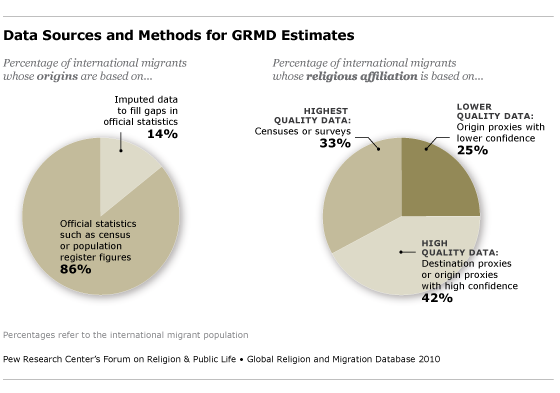
Estimating the religious makeup of immigrants involved an additional layer of data collection and analysis. The most reliable information on the religion of migrants comes from censuses or large-scale surveys that contain questions about immigrants’ religious affiliation as well as about their country of birth. This kind of data was available for about one-third of the world’s migrant population, including for immigrants in many of the leading destination countries, such as the United States, Canada, Australia and the United Kingdom.
In cases in which no data were available on the religious affiliation of migrants in a particular country, the Pew Forum sometimes was able to use census or survey data from a religiously similar country in the same region as a “destination proxy.” For example, Bahrain does not release detailed data on the religion of its immigrants. But data are available on the religious affiliation of immigrants to Egypt, which, like Bahrain, is a Muslim-majority country in the Middle East-North Africa region. So in estimating the percentage of Muslims, Christians, Hindus and members of other religious groups among migrants from India to Bahrain, the Pew Forum used the religious breakdown of migrants from India to Egypt as a guide. This is important because migrants often do not match the religious composition of their home country. Even though India is a Hindu-majority country, for example, most migrants from India to Egypt are Muslims – and the same is assumed to be true of most migrants from India to Bahrain.
The religious distribution of the remaining migrants was estimated using an “origin proxy.” This assumes that the religious makeup of migrants is roughly the same as the religious makeup of the country they come from, particularly when they are moving between countries in which the majority religion is the same, such as migrants moving from Latin America to the United States. Origin proxies also were used in some cases in which migrants originate from a country composed almost entirely of a single religious group, such as migrants from Turkey to Europe. Data reliability tests indicate that selective use of origin proxies in these circumstances is highly reliable. Combined with destination proxies (7%), origin proxies with a high level of data confidence (35%) were the basis for estimating the religious composition of about 42% of the migrant population.
The religious distribution of the remaining 25% of global migrants also is based on origin proxies, but in circumstances in which the religious composition of the emigrant population may differ significantly from the religious composition of the origin country. Migrants from Cameroon to Belgium, for example, are assumed – in the absence of other data – to have the same religious breakdown as Cameroon’s population, which is about 70% Christian and roughly 20% Muslim. In reality, however, there may be a higher percentage of Christians among migrants from Cameroon to Belgium (a Christian-majority country) than there is in Cameroon’s population as a whole. In such circumstances, the origin proxies yield less reliable estimates of religious affiliation. Many of the estimates with a lower level of data confidence, however, are for the movement of relatively small numbers of migrants between countries that are neither major origins nor major destinations.
Taking these limitations into account, this report focuses on the Top 10 origin countries and the Top 10 destination countries of each religious group – estimates that generally are based on censuses, surveys or proxies with a high level of data confidence. The report also highlights broad patterns in migration across major geographic regions, such as Europe and the Middle East-North Africa. Throughout the report and the accompanying interactive graphics, large numbers are rounded to the nearest 10,000. Estimates between 1,000 and 9,999 are shown as <10,000. Estimates between 0 and 999 are shown as <1,000. All percentages are rounded to whole numbers.
For a more detailed explanation of the construction of the Global Religion and Migration Database, including data reliability tests, see the Methodology section (Appendix B). A complete list of the data sources used for each country, including proxies, is provided in Appendix C.
Footnotes:
1 Comparisons in this report to the world’s religious distribution rely primarily on figures from Boston University’s World Religion Database. The Pew Forum is currently compiling detailed statistics on the size and distribution of the world’s major faiths based on censuses and national surveys. Some of those figures were released in The Future of the Global Muslim Population: Projections for 2010-2030 (January 2011), which estimated that Muslims comprised about 23% of the global population in 2010, and in Global Christianity: A Report on the Size and Distribution of the World’s Christian Population (December 2011), which estimated that Christians made up nearly 32% of the world’s people in 2010. (return to text)
